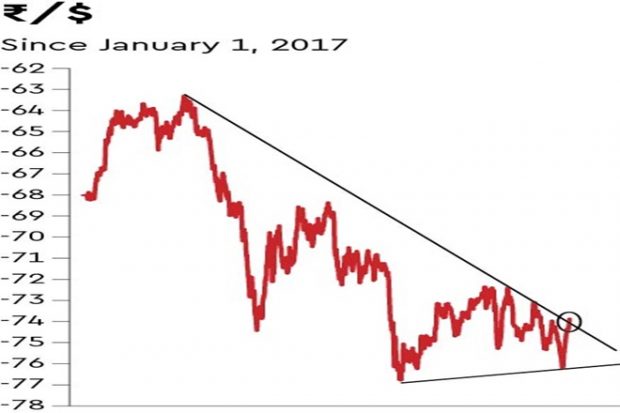[ad_1]
RIL’s $4-billion bond issue was clearly the main force that pushed the rupee higher these past couple of days, taking it above 74 and crossing a nearly five-year-old resistance line. Of course, RBI jumped in buying dollars after a long time, reversing its recent practice when it sold dollars to protect against rupee weakness in 13 of the past 17 weeks.
The big questions, of course, are whether (a) rupee strength will sustain, and (b) RBI will continue its efforts to prevent rupee strength, and if so, will it be successful.

There are many forces affecting rupee strength. The largest umbrella is global dollar strength/weakness; DXY has risen from sub-90 in June/July this year, when the first talk about inflation and Taper II began to circulate. It reached a peak of 96.50 in mid-December, when it became clear that the Fed was on the job and US rates were set to rise—indeed, at its last meeting the Fed has penciled in 4 rate rises this year. The market appears less nervous than it was just a month or so ago, when it felt like the Fed was behind the curve—US equities have steadied and look to rise further. On the flip side, interest rates in other major economies are also going up—German bunds appear to be coming out from underwater for the first time in nearly three years—and this could contain further dollar strength.
The second, and more direct, factor affecting rupee strength is, of course, supply of and demand for dollars. It would seem that, with US interest rates going up, there will likely be several other large Indian companies that follow RIL’s lead and issue bonds overseas—global bond markets are rocking with over USD 100 bn already raised in the first 10 days of the year. Again, with a continuing list of IPOs planned in the near future, notably including LIC, and, of course, the ever-hungry private investor universe which apparently sees huge profits in India, equity inflows should also be strong, with Indian markets again targeting all-time highs. There could be corrections, of course, but directionally I think money will continue to come into India. And then there is the prospect of Indian bonds being included in global bond indices as early as the budget or soon thereafter. This could be huge—we note that in August, when the first whispers of this possibility were mooted, we saw $1.5 billion of debt inflows in a day! Given all this, we believe the physical flows would, again, help contain the current account deficit, which will, however, despite strong—indeed record—exports, rise over the next few quarters, since imports are growing like gangbusters.
Which brings us to the second question—whether RBI will continue its efforts to prevent rupee strength. In most circumstances, we would expect that RBI would eagerly get back on the job of buying dollars to build reserves and prevent rupee strength. However, with inflation becoming more and more of a major issue and, crucially, a whole slew of assembly elections set for Valentine’s Day, RBI may find itself politically compelled to allow more rupee strength, by raising rates in tandem with the Fed—local money markets are already climbing higher—and/or letting the rupee strengthen some more.
On the flip side of the equation is, again, the increasing uncertainty around the state elections, most critically, in UP. The momentum there, as in other states, certainly appears to be swinging quickly away from the BJP, and if they were to lose UP, or even suffer a severe setback, political risk could get much, much louder and we could see equity markets and the rupee tank.
Of course, Narendra Modi is known to be a conjurer with different rabbits that he can pull out of multiple hats. Before the last UP polls, it was demonetisation, which in one stroke rendered all the opposition parties cashless, and, hence, toothless. It would seem the old stand-by—demonizing minorities—may be too weak a weapon, particularly in the current mood, and with very little time left. There is always Pakistan, of course, to use as a bogeyman, but they seem focused on their own problems and I don’t think Modi would trigger a conflict to help him win some points in the local elections— indeed, with Punjab also going to the polls, this could be particularly dangerous. But, writing off Modi at any time is a foolishness, so there has to be some—and, perhaps, a significant— probability of politics generating high volatility.
As always, keep your head down and follow a structured process for hedging—importers should follow a trailing stop loss approach; exporters should keep hedging at every opportunity following pre-set rules.
The author is CEO, Mecklai Financial
http://www.mecklai.com
[ad_2]
Source link

